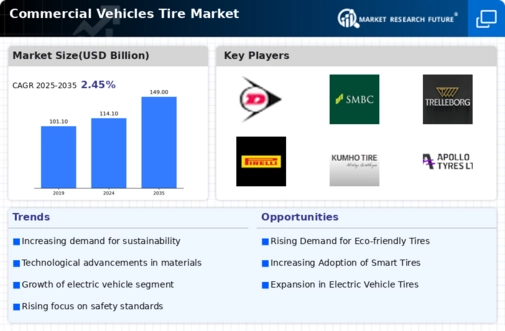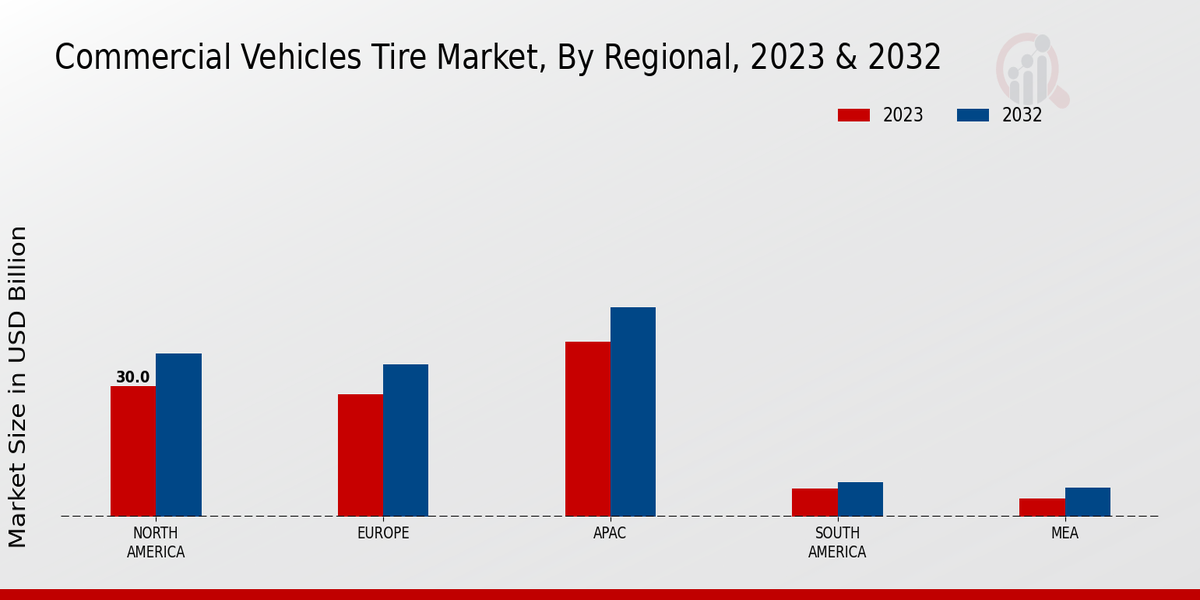Market Growth Projections
The Global Commercial Vehicles Tire Market Industry is poised for steady growth, with projections indicating a compound annual growth rate (CAGR) of 2.45% from 2025 to 2035. This growth trajectory is supported by various factors, including increased demand for commercial vehicles, technological advancements, and regulatory compliance. As the market evolves, manufacturers are likely to adapt to changing consumer preferences and invest in innovative tire solutions. The anticipated market value of 149.0 USD Billion by 2035 underscores the potential for expansion and the importance of strategic planning in this competitive landscape.
Growing Demand for E-commerce Logistics
The surge in e-commerce has led to an increased demand for commercial vehicles, thereby driving the Global Commercial Vehicles Tire Market Industry. With online retail sales projected to reach unprecedented levels, logistics companies are expanding their fleets to meet consumer expectations. This expansion necessitates a corresponding increase in tire production and innovation. As of 2024, the market is valued at 114.1 USD Billion, reflecting the growing reliance on commercial vehicles for timely deliveries. The need for durable and efficient tires is paramount, as logistics providers seek to optimize their operations and reduce costs, further propelling market growth.
Regulatory Compliance and Safety Standards
Stringent regulations regarding vehicle safety and emissions are shaping the Global Commercial Vehicles Tire Market Industry. Governments worldwide are implementing policies that require commercial vehicles to meet specific safety standards, which directly impacts tire specifications. Compliance with these regulations often necessitates the adoption of high-quality tires that can withstand rigorous testing. As a result, manufacturers are compelled to innovate and enhance their product offerings. This regulatory landscape not only ensures safer roads but also drives market growth, as companies invest in tires that meet or exceed these standards, thereby expanding their market presence.
Sustainability and Eco-friendly Initiatives
The increasing emphasis on sustainability is reshaping the Global Commercial Vehicles Tire Market Industry. Companies are increasingly adopting eco-friendly practices, including the use of sustainable materials in tire production. This shift is driven by consumer demand for greener products and regulatory pressures to reduce carbon footprints. As a result, manufacturers are exploring alternative materials and recycling methods to produce tires that are both efficient and environmentally friendly. This trend is expected to gain momentum, potentially influencing market dynamics and leading to a more sustainable future for the commercial vehicle tire sector.
Expansion of Infrastructure and Urbanization
The ongoing expansion of infrastructure and urbanization is a crucial driver of the Global Commercial Vehicles Tire Market Industry. As urban areas grow and infrastructure projects proliferate, the demand for commercial vehicles rises, subsequently increasing the need for tires. Governments are investing heavily in transportation networks, which enhances logistics and distribution capabilities. This trend is expected to contribute to the market's growth, with projections indicating a market value of 149.0 USD Billion by 2035. The need for reliable and high-performance tires becomes increasingly critical as commercial vehicles play a vital role in supporting economic development.
Technological Advancements in Tire Manufacturing
Innovations in tire manufacturing technology are significantly influencing the Global Commercial Vehicles Tire Market Industry. The introduction of advanced materials and production techniques enhances tire performance, durability, and safety. For instance, the development of smart tires equipped with sensors can provide real-time data on tire pressure and wear, improving fleet management. These advancements not only cater to the growing demand for high-performance tires but also align with sustainability goals. As the market evolves, manufacturers are likely to invest in research and development, which could lead to a more competitive landscape and increased market share.











